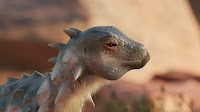 |
| Jakapil kaniukura Riguetti, Apesteguía & Pereda-Suberbiola, 2022 |
Abstract
The early evolution of thyreophoran dinosaurs is thought to have occurred primarily in northern continents since most evidence comes from the Lower and Middle Jurassic of Europe and North America. The diversification into stegosaurs and ankylosaurs is obscured by a patchy fossil record comprising only a handful of fragmentary fossils, most with uncertain phylogenetic affinities. Here we report the discovery of a new armoured dinosaur from the early Late Cretaceous of Argentina, recovered phylogenetically using various datasets either as a basal thyreophoran or a stem ankylosaur, closely related to Scelidosaurus. It bears unusual anatomical features showing that several traits traditionally associated with the heavy Cretaceous thyreophorans did not occur universally. Jakapil kaniukura gen. et sp. nov. is the first definitive thyreophoran species from the Argentinian Patagonia. Unlike most thyreophorans, it seems to show a bipedal stance, as in Scutellosaurus. Jakapil also shows that early thyreophorans had a much broader geographic distribution than previously thought. It is a member of an ancient basal thyreophoran lineage that survived until the Late Cretaceous in South America.
Systematic paleontology
Dinosauria Owen, 1842
Ornithischia Seeley, 1887
Thyreophora Nopcsa, 1915
Jakapil kaniukura gen. et sp. nov.
Diagnosis: Jakapil differs from all other thyreophorans in having: a large, ventral crest on the posterior half of the lower jaw, which is composed of the dentary, the angular and the splenial (medially hidden by the crest); a dorsomedially directed process in the short retroarticular process; leaf-shaped tooth crowns with a prominent mesial edge on their labial surface; maxillary and dentary tooth crowns differ from each other in their apical contour, the former being pointed and strongly asymmetrical, and the latter slightly curved distally with a more rounded and less asymmetrical contour; elongated (articular surface almost or completely beyond the posterior centrum face) and slender (width of less than a half postzygapophyses length) postzygapophyses in dorsal vertebrae; a strongly reduced humerus relative to the femur (proximal humeral width smaller than distal femoral width, see Supplementary Information), with a deep proximal fossa distally delimited by a curved ridge; a very large fibula relative to the femur (anteroposterior length of the proximal end almost comparable to the distal width of the femur); flattened and thin disk-like postcranial osteoderms.
Locality and horizon: Upper beds of the Candeleros Formation, early Late Cretaceous (Cenomanian, ~ 94–97 My, see16, and references therein), locality of Cerro Policía, Río Negro Province, North Patagonia, Argentina (Suppl. Fig. 1).
Etymology: The genus, Jakapil (Ja-Kapïl: shield bearer), comes from the ‘gananah iahish’, Puelchean or northern Tehuelchean language. The specific epithet, comprising kaniu (crest) and kura (stone), refers to the diagnostic ventral crest of the mandible, and comes from the Mapudungun language. These languages, currently spoken by more than 200,000 people, have been combined as a tribute to both of the coexisting native populations of North Patagonia, South America.
Facundo J. Riguetti, Sebastián Apesteguía and Xabier Pereda-Suberbiola. 2022. A New Cretaceous Thyreophoran from Patagonia supports A South American Lineage of Armoured Dinosaurs. Scientific Reports. 12: 11621. DOI: 10.1038/s41598-022-15535-6
Researchgate.net/publication/362643937_A_new_Cretaceous_thyreophoran_from_Patagonia








